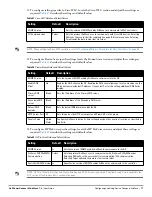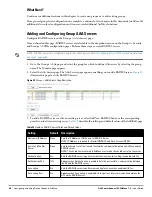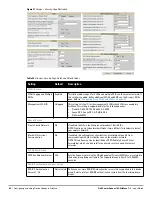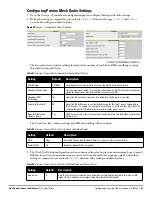
Dell PowerConnect W-AirWave 7.4
| User Guide
Configuring and Using Device Groups in AirWave |
89
4. Certain wireless access points offer proprietary settings or advanced functionality that differ from prevailing
industry standards. If you use these APs in the device group, you may wish to take advantage of this
proprietary functionality.
To configure these settings, locate the proprietary settings areas on the Groups > Radio page and continue
with the additional steps in this procedure.
5. To configure settings specific to the Proxim AP-600, AP-700, AP-2000, AP-4000; Avaya AP-3/4/5/6//7/8, and
ProCurve 520WL, locate the appropriate section of Groups > Radio page and define the required fields.
Table 63
describes the settings and default values.
Maximum Data Retries
32
The maximum number of attempts the AP makes to send a packet before giving up
and dropping the packet. Acceptable values range from 1 to 255.
Beacon Period (19-5000
msec)
100
Time between beacons (in microseconds).
DTIM Period (1-255)
2
DTIM alerts power-save devices that a packet is waiting for them. This setting
configures DTIM packet frequency as a multiple of the number of beacon packets.
The DTIM Interval indicates how many beacons equal one cycle.
Ethernet Encapsulation
RFC1042
This setting selects either the RFC1042 or 802.1h Ethernet encapsulation standard for
use by the group.
Radio Preamble
Long
This setting determines whether the APs uses a short or long preamble. The
preamble is generated by the AP and attached to the packet prior to transmission.
The short preamble is 50 percent shorter than the long preamble and thus may
improve wireless network performance.
NOTE: Because older WLAN hardware may not support the “short” preamble, the
“long” preamble is recommended as a default setting in most environments.
Table 62
Groups > Radio > Radio Settings Fields and Default Values (Continued)
Setting
Default
Description
NOTE: Proprietary settings are only applied to devices in the group from the specific vendor and are not configured on devices
from vendors that do not support the functionality.
Table 63
Groups > Radio > Proxim AP-600, AP-700, AP-2000, AP-4000; Avaya AP-3, Avaya AP-7, AP-4/5/6, AP-8;
ProCurve520WL Fields and Default Values
Setting
Default
Description
Load Balancing
No
If enabled, this setting allows client devices associating to an AP with two radio cards
to determine which card to associate with, based on the load (# of clients) on each
card.
NOTE: This feature is only available when two 802.11b wireless cards are used in an
AP-2000.
Interference Robustness
No
If enabled, this option will fragment packets greater than 500 bytes in size to reduce
the impact of radio frequency interference on wireless data throughput.
Distance Between APs
Large
This setting adjusts the receiver sensitivity. Reducing receiver sensitivity from its
maximum may help reduce the amount of crosstalk between wireless stations to
better support roaming users. Reducing the receiver sensitivity, user stations will be
more likely to connect with the nearest access point.
802.11g Operational
Mode
802.11b
+802.11g
This setting sets the operational mode of all g radios in the group to either b only, g
only or b + g.
802.11abg Operational
Mode
802.11b
+802.11g
This setting sets the operational mode of all a/b/g radios in the group to either a only, b
only, g only or b + g.
802.11b Transmit Rate
Auto
Fallback
This setting specifies the minimum transmit rate required for the AP to permit a user
device to associate.
Содержание PowerConnect W-Airwave
Страница 1: ...Dell PowerConnect W AirWave 7 4 User Guide ...
Страница 106: ...106 Configuring and Using Device Groups in AirWave Dell PowerConnect W AirWave 7 4 User Guide ...
Страница 256: ...256 Creating Running and Emailing Reports Dell PowerConnect W AirWave 7 4 User Guide ...
Страница 310: ...310 Index Dell PowerConnect W AirWave 7 4 User Guide ...






























